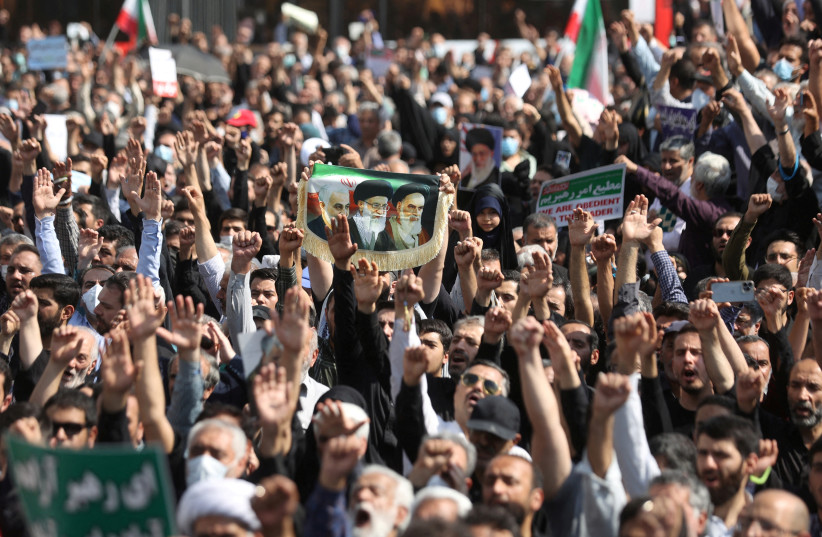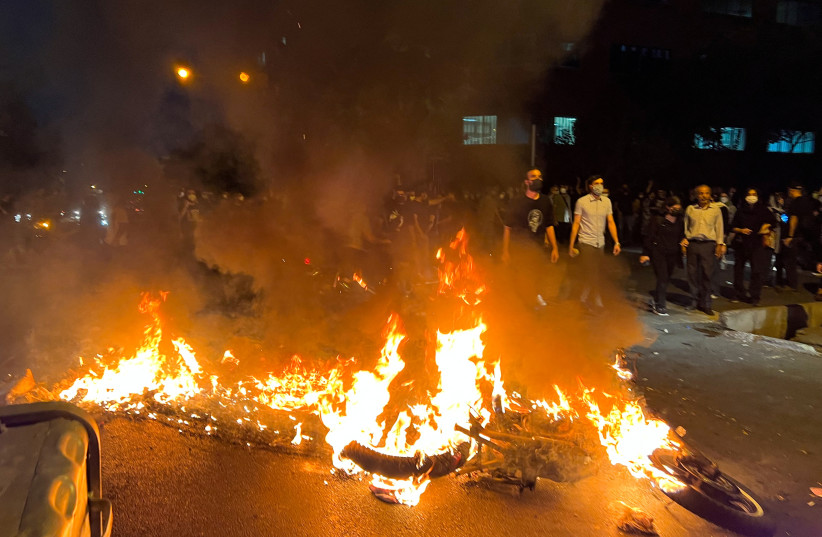The Islamic Republic could be faced with global snapback sanctions which would apply even to Russia and China.

Iran is trying to maintain an uncompromising stance in every area, but is up against the wall more than it has been in prior years both regarding the IAEA nuclear standoff and in confronting domestic protests.
Normally, when the Islamic Republic tries to govern its foreign and internal problems using an iron hand, those it is up against retreat or back down.
What is unique now is that Tehran has pulled out the stops against both the IAEA and domestic protesters, and both of these challengers appear ready to escalate and could potentially shake the foundations of the regime.
Against the IAEA and its US and EU supporters, Iran Supreme Leader Ayatollah Ali Khamenei has limited aspects of cooperation now dating back to February 2021 and has cut off 27 key surveillance cameras for the last half-year.
Khamenei has also repeatedly refused to clarify to the IAEA the true stories behind illicit uranium and undeclared nuclear sites that the Mossad exposed dating back to 2018.

Just as IAEA Director-General Rafael Grossi was appealing to Khamenei through the media last week to accelerate dialogue with his agency to overcome roadblocks on these issues, Iran decided to cancel holding any meeting with Grossi in the near future.
Has their patience run out?
But the IAEA and the West’s patience may have run out.
They issued a second condemnation of Tehran regarding its nuclear violations and obstruction, and this time there were hints that the IAEA may finally send the issue to the UN Security Council when its next meeting comes up in March 2023.
If it goes the distance in the UNSC, the Islamic Republic could be faced with global snapback sanctions that would apply even to Russia and China.
The way that the 2015 JCPOA deal was set up, neither Moscow nor Beijing could veto snapping-back sanctions if the IAEA Board sends the issue to the UNSC.
Although much of the world has been observing sanctions against Tehran, one reason Khamenei has been able to resist the US’s “maximum pressure” campaign has been because Russia, China and others have disregarded Washington’s dictates.
When Khamenei caved into a serious negotiations process in 2012 and signed the JCPOA in 2015, it was only when sanctions were being observed by all countries.
In that sense, if the issue finally goes to the UNSC in mid-2023, Iran could suddenly face the most intense sanctions pressure in over a decade.
All of this is happening at the same time as a nine week-long protest against the regime is starting to break various records.
No one knows the real numbers, but media reports are saying that close to 400 Iranians have been killed and around 15,000 have been arrested by the regime.
During the November 2019-July 2020 protests, it is estimated that 1,500 people were killed. June-December 2009 were probably the protests that most endangered the regime because former national leaders sided with the protesters and there was a clear group that could have replaced the regime.
So in some ways the current protests have still not hit the same heights as those earlier rounds of protests.
The number of killed has not yet broken records. There is still no coherent leadership or organization uniting all of the disparate protesters in a country that is so large that it could fit several of Europe’s largest countries inside.
The regime has control of the Internet and has the Basij militia force and backup from the IRGC, who are willing to beat their own people so that it can keep the military out of most issues (Iran learned from the USSR that professional military soldiers are not always willing to fire on their own people).
Khamenei hand-picked current hardliner Ebrahim Raisi as president in June 2021 to replace the somewhat more moderate Hassan Rouhani.
Raisi is famous for helping lead a domestic crackdown in the 1980s that led to mass casualties and executions.
But the Khamenei-Raisi team assumed that their harsh crackdowns on the protesters would fizzle the widespread anti-government movement within around a month.
What is unique this time is that the protests have been national the whole time, including in Shi’ite strongholds, where killing and oppressing women has broken a restraint that kept many Shi’ites out of earlier rounds of protests.
It is also possible that Khamenei’s blatant canceling of any potential legitimate electoral challenger to Raisi eliminated a horizon of potential hope of many average Iranians that their situation could improve cyclically when there would be elections.
Whatever the reason, even if the protesters are not yet close to toppling the regime, they are bringing the ayatollahs into a new reality of having to continuously live with widespread protests, not just in Kurdish and minority areas, but on their hometown Shi’ite turf.
It is unclear if Khamenei will unleash new levels of violence against his own people, including Shi’ites, or whether even that level of brutish violence would be enough to extinguish the current level of animosity to the regime.
In this volatile situation, the face of Iranian public and basic social relations may change in fundamental waves even as the regime has multiple powerful tools to survive.
The last unknown is whether the confluence of these two crises, one external and one internal, will lead to some other new state of play.
Until now, the regime has simply presented a tougher and harder line on both fronts.
But whether the synergy of the two will at some point explode and make the regime entertain new levels of aggression or retreat in a way that it has not done in a decade or more is the million-dollar question.
Advertisement
Content retrieved from: https://www.jpost.com/middle-east/iran-news/article-722925.